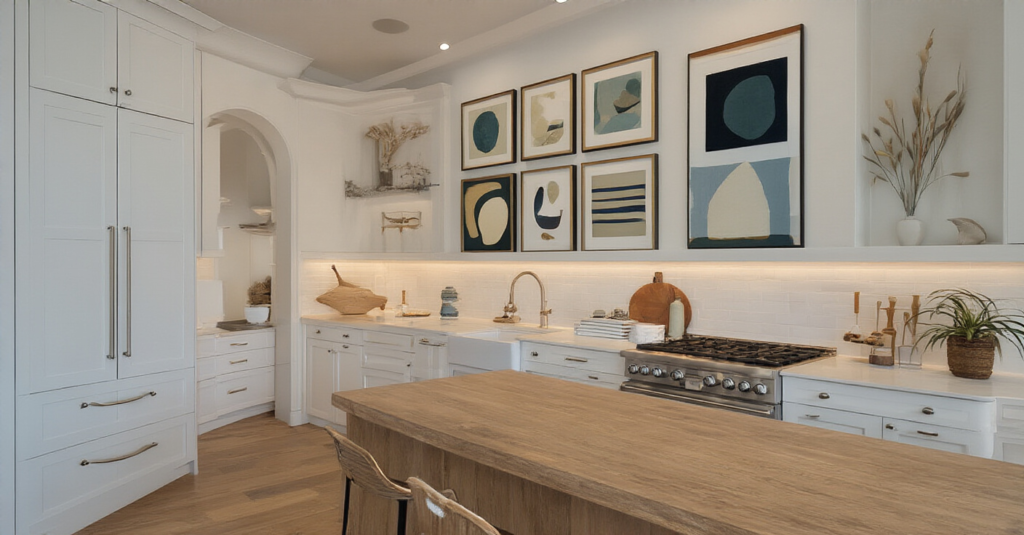You know what people always ask me? “Jasmine, how do I bring in that amazing, rich Indian feel without it looking like a chaotic museum or… my grandmother’s house?” They see the photos from my trips to Jaipur, the textiles, the colors, the energy, and they want a piece of it, but they live in a modern home with clean lines. They think it’s an impossible contradiction.
But here’s the secret: It’s not about replicating a palace in Rajasthan. It’s about capturing a feeling. It’s about understanding that a home, especially a kitchen, should be alive. It should be layered with stories, textures, and moments that make you smile. The real BS is the idea that modern design has to be cold and sterile. That’s just noise. What truly matters is creating a space that feels like you—a space that’s as full of flavor and personality as the food you cook. So let’s forget the rules for a second and talk about what really works.
Foundational Planning for a Soulful Space
Okay, before we get to the fun part—the color and treasure-hunting—we have to lay the groundwork. Think of it like making a perfect biryani. You can’t just throw everything in the pot. You have to prep your ingredients, understand the spices, and build the layers with intention. This is the part that ensures your kitchen looks thoughtfully curated, not just randomly decorated.
1. Assess Your Kitchen’s Existing Style
Forget trying to perfectly “match” everything. That’s how you get a boring, one-note room. Instead, think of your kitchen’s existing style—the cabinets, the countertops—as the rhythm section. It’s the steady beat. Your job is to add the melody. Is your kitchen sleek and modern? Fantastic. Let’s find an antique, hand-carved wooden panel to create a stunning dance between old and new. Got a farmhouse vibe? Let’s bring in some vibrant Blue Pottery from Jaipur to cut through the rustic-ness with a shot of electric color.
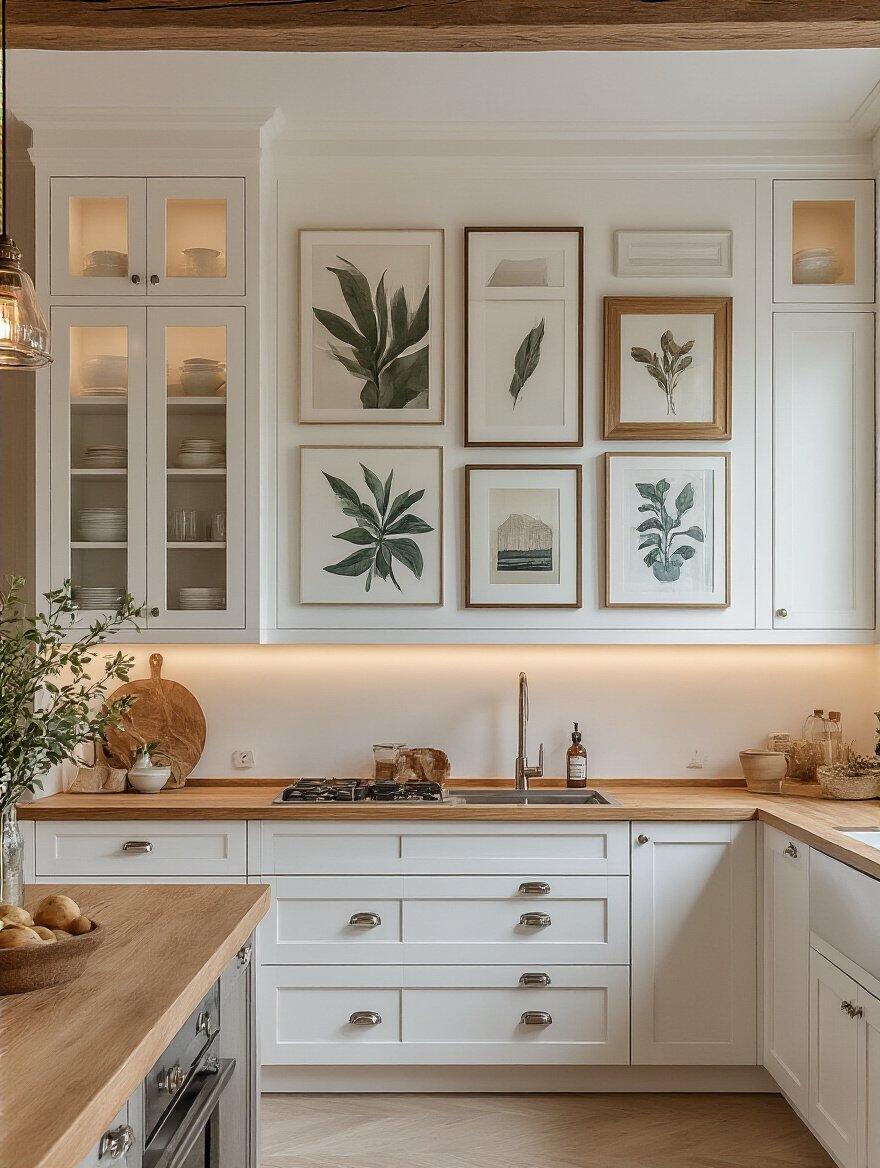
The goal isn’t sterile cohesion; it’s a dynamic conversation between elements. A client of mine had a super modern, all-white kitchen that felt cold. We didn’t change a single cabinet. We just added a backsplash of handmade emerald green zellige tiles and suddenly, the whole space came alive. It learned to speak a new, more joyful language. That’s what we’re aiming for.
2. Define Each Wall’s Purpose
Now, look at your walls. Each one has a job to do. Is this a wall for quiet beauty, a place for a single, stunning piece of art to breathe? Or is this a workhorse wall next to the stove that needs to be all about function—spices, utensils, a place to hang your copper pans? Deciding this upfront saves you so much headache later.
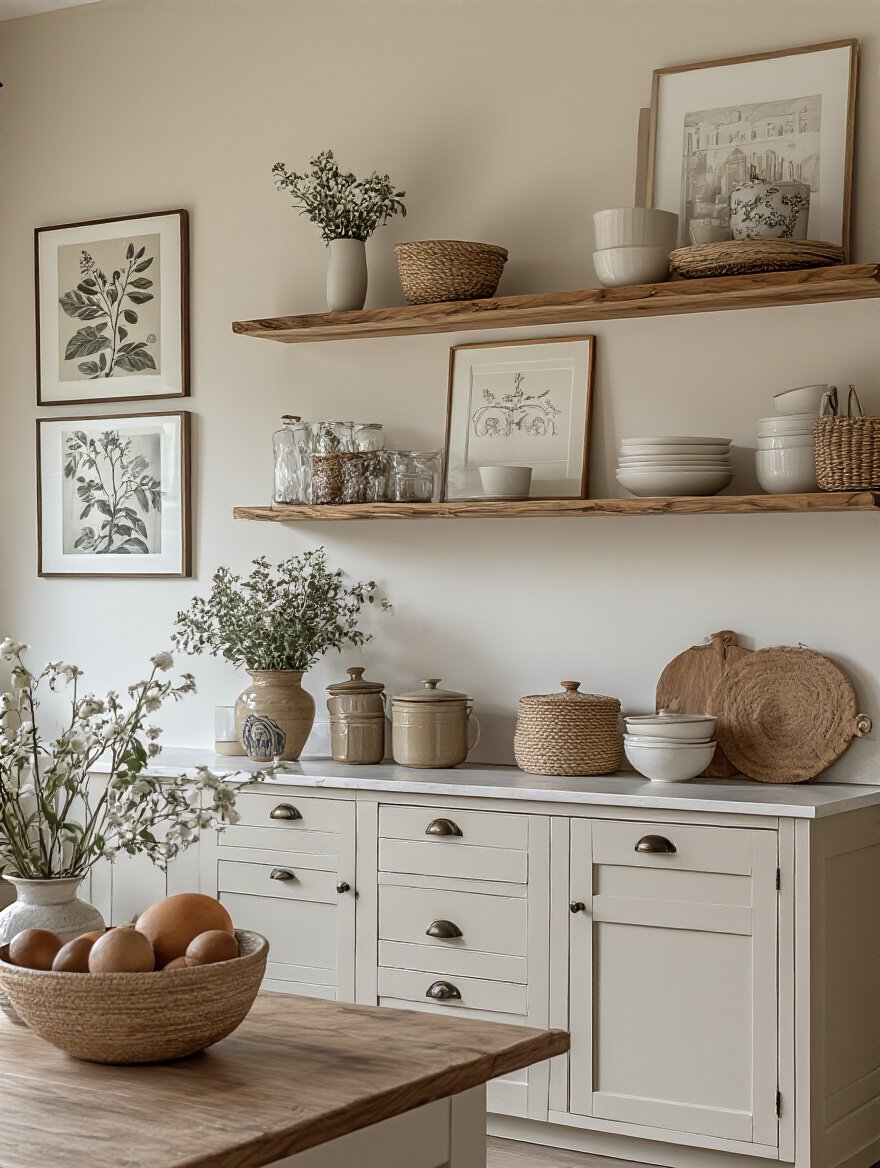
Don’t make the mistake of trying to make every wall do everything. I once worked with a family who put a delicate, beautiful textile hanging right next to their stove. It was gorgeous for about a week, until it was covered in a fine film of grease and turmeric stains. Be honest about how you live and cook. Designate a “gallery” wall for beauty and a “command center” wall for function. Or find a beautiful balance between the two.
3. Measure Your Wall Space (with Respect!)
This sounds so basic, I know. But here’s my spin on it: measuring isn’t just about making sure things fit. It’s about respecting the space. The empty space, the “negative space,” is just as important as the object you hang in it. It gives your art, your shelves, your treasures room to be seen and appreciated. It’s the pause in the music that makes the notes sing.
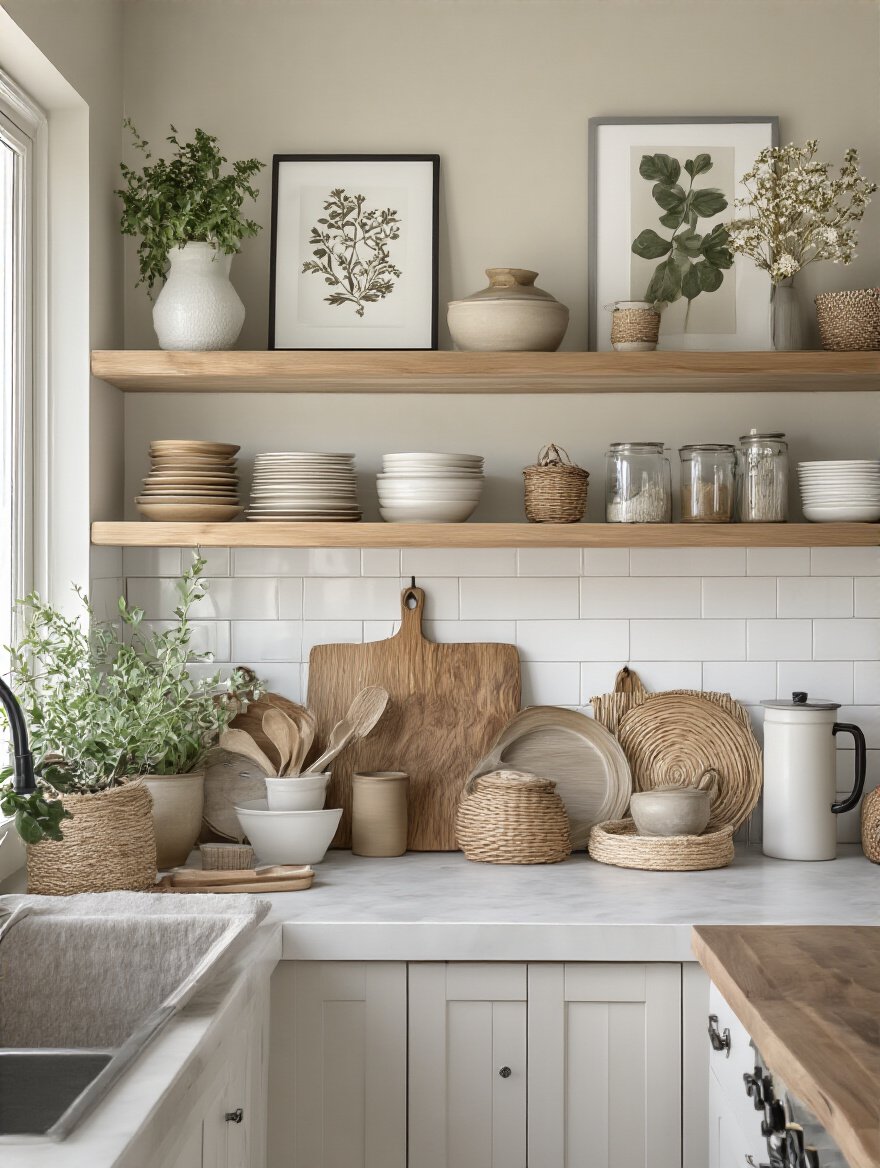
So before you buy that enormous antique mirror, tape out its dimensions on the wall. Live with the outline for a day. Does it feel powerful or oppressive? Does it dwarf everything else? Taking five extra minutes to measure and create a simple paper template will save you from the heartbreak of an impulse buy that just doesn’t work. It’s the difference between a confident design choice and a cluttered mess.
4. Choose Finishes That Can Handle the Turmeric Test
Let’s be real: kitchens are battlegrounds of spices, oils, and splatters. I’m from a culture where turmeric gets on everything. So, can we please talk about why people choose delicate, matte-finish paints for their kitchen walls? It’s a design sin! You need finishes that are as resilient as they are beautiful.
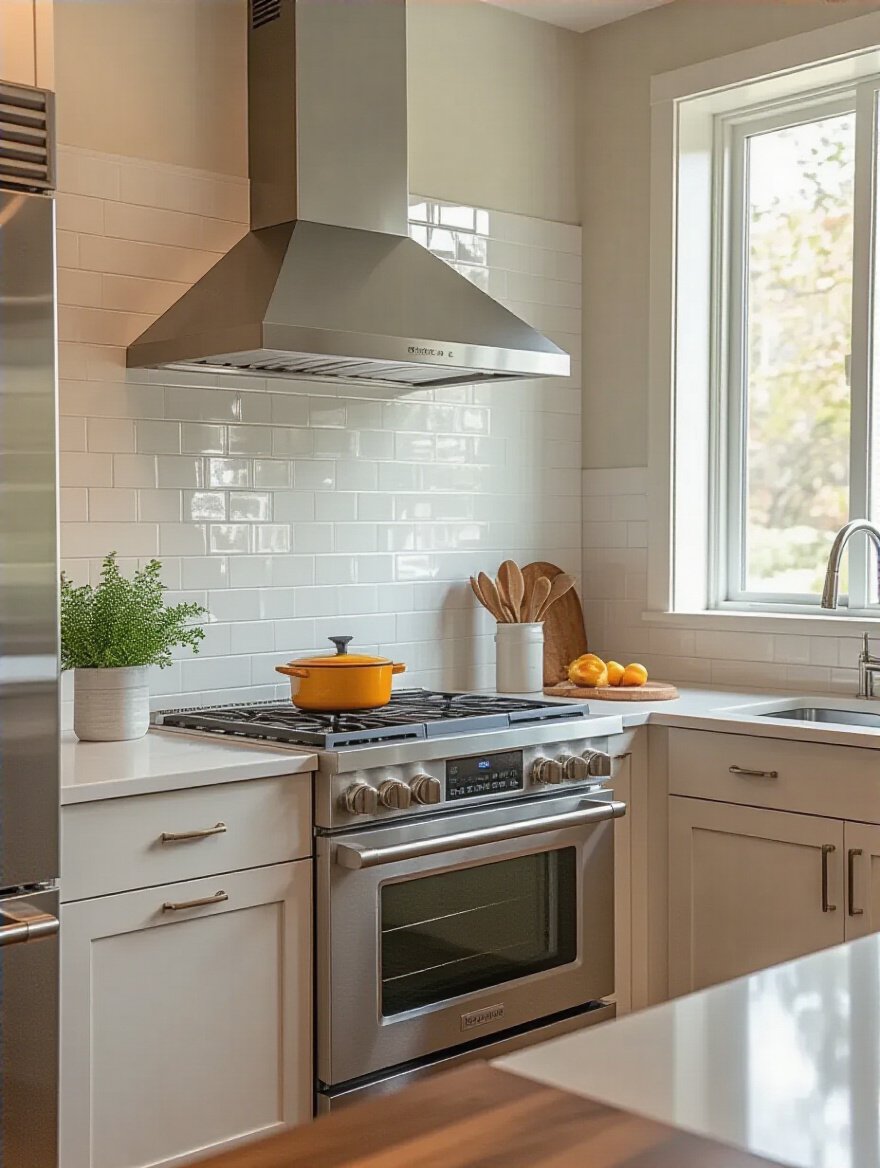
Think high-quality, scrubbable paint in a satin or semi-gloss finish. It will be your best friend. For backsplashes, glazed tiles are a dream to wipe down—and you can find them in the most glorious colors and patterns. My shortcut? I test samples. I literally take a sample of tile or paint, smear some tomato paste or turmeric oil on it, let it sit, and see how easily it cleans up. If it can’t pass that test, it has no place in the heart of the home.
5. Create a Budget That Allows for a Little Magic
A budget isn’t a creative cage; it’s a treasure map. It tells you where to spend your gold and where to be clever. You absolutely must set a realistic budget, but here’s the key: always, always build in a 10-15% “magic fund.” This isn’t just for mistakes. This is for the moment you’re at a flea market and you find the perfect set of antique spice tins that weren’t in the plan. It’s for when you realize you need a slightly more expensive frame to make a piece of art truly sing.
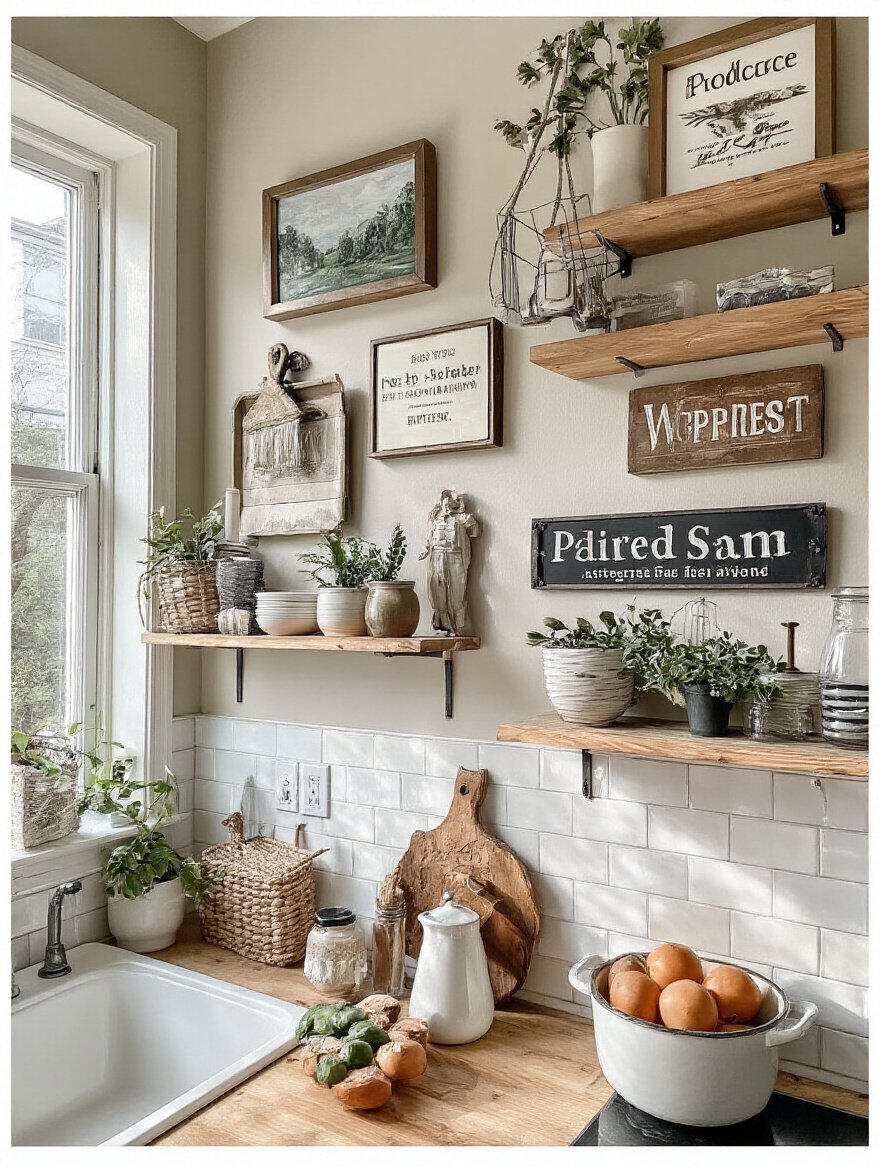
I learned this the hard way when I found a stunning, reclaimed jharokha (a traditional Rajasthani enclosed balcony window) for a client’s kitchen. It was a bit over her art budget, but because we had that little cushion, she could get it. It completely transformed her space from “nice kitchen” to “unforgettable room with a soul.” That’s what the magic fund is for.
Smart Storage & Functional Display Solutions
Now for the fun part! Let’s make your walls work for you. In India, you see the most beautiful and ingenious storage. Everything is out, accessible, and part of the visual feast. It’s not about hiding things away; it’s about celebrating the tools of your craft. Let’s bring that spirit into your home.
6. Maximize Vertical Space with open shelving
Everyone says open shelves are for minimalists. I completely disagree. Open shelves are for storytellers. This is your stage! Don’t just line up identical white mugs. Display the beautiful, hand-painted ceramic martabans (jars) you picked up on your travels. Showcase your gleaming brass thalis or a stack of colourful enamelware. Mix in cookbooks, a small plant, and a framed photo.
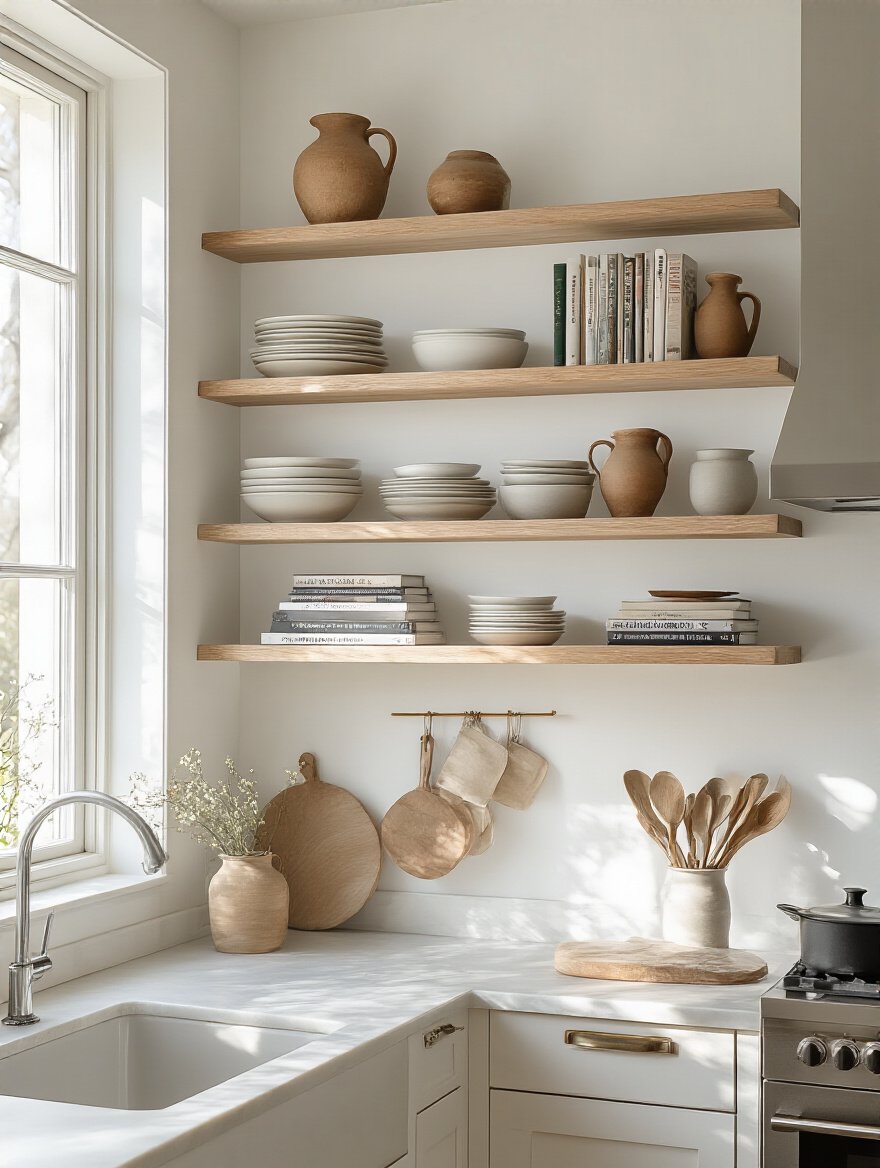
The key is variety and balance. I love using reclaimed wood for shelves; it brings so much warmth. And here’s the secret to making them look curated, not cluttered: think in triangles. Create little vignettes of objects at different heights, and leave some breathing room around each grouping. It’s a display of your life, not just your dishes.
7. Install a Wall-Mounted Rack for Functional Art
Why hide your beautiful pots and pans? A good pot rack isn’t just storage; it’s a sculpture. Especially if you have a collection of gorgeous hammered copper handis or cast-iron skillets. Hanging them on the wall frees up precious cabinet space and turns them into an intentional part of your decor. It adds an immediate layer of rustic, hearty charm.
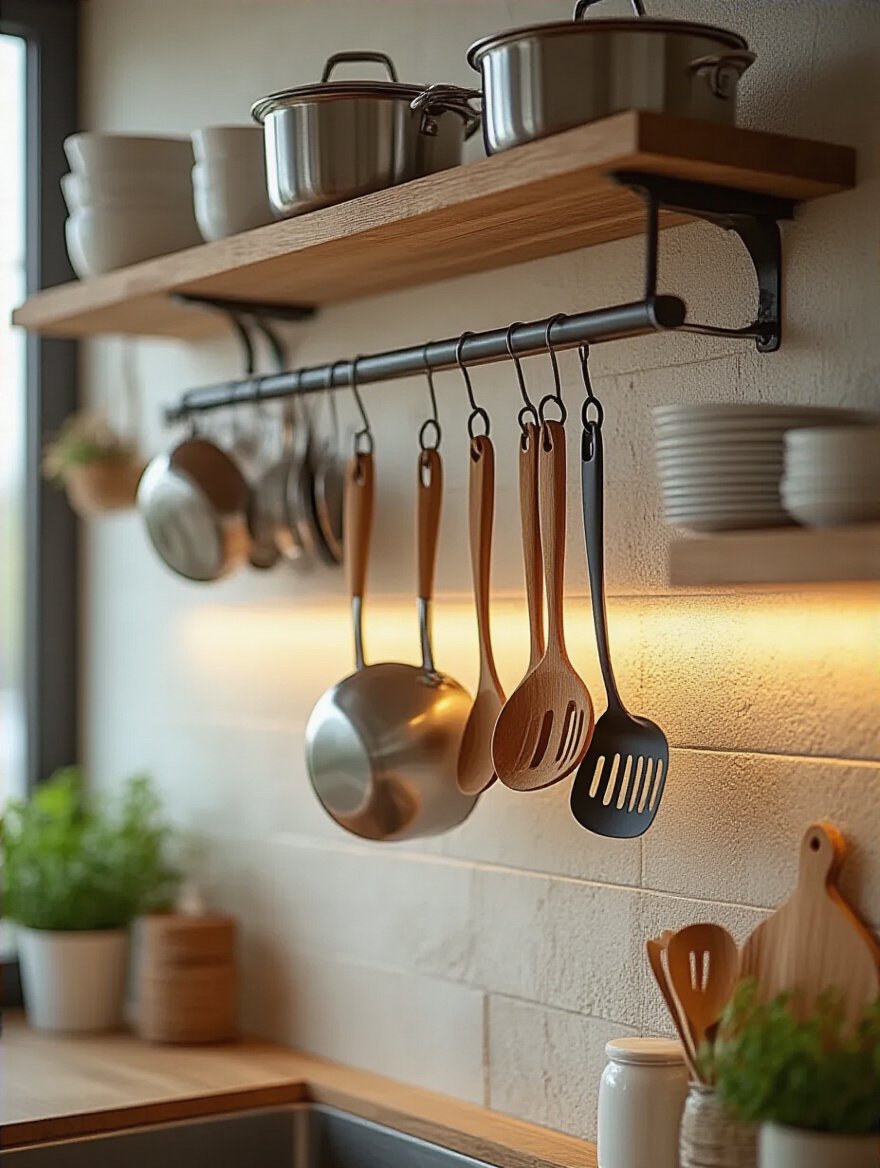
You can find sleek, modern rails or more rustic, industrial-style grids. My personal favorite is mounting a sturdy piece of reclaimed wood and adding heavy-duty S-hooks. It feels authentic and warm. Plus, having your most-used pans within easy reach is a game-changer when you’re in the middle of cooking. Function and beauty, hand in hand.
8. Create a Magnetic Knife Strip for Sleek Safety
Okay, this one is pure, brilliant function. Knife blocks are clunky, take up valuable counter space, and can be a nightmare to clean. A magnetic knife strip is sleek, hygienic, and keeps your sharpest tools safely out of reach of little hands, but perfectly accessible for you. It’s a touch of modern efficiency that can live happily next to more traditional elements.
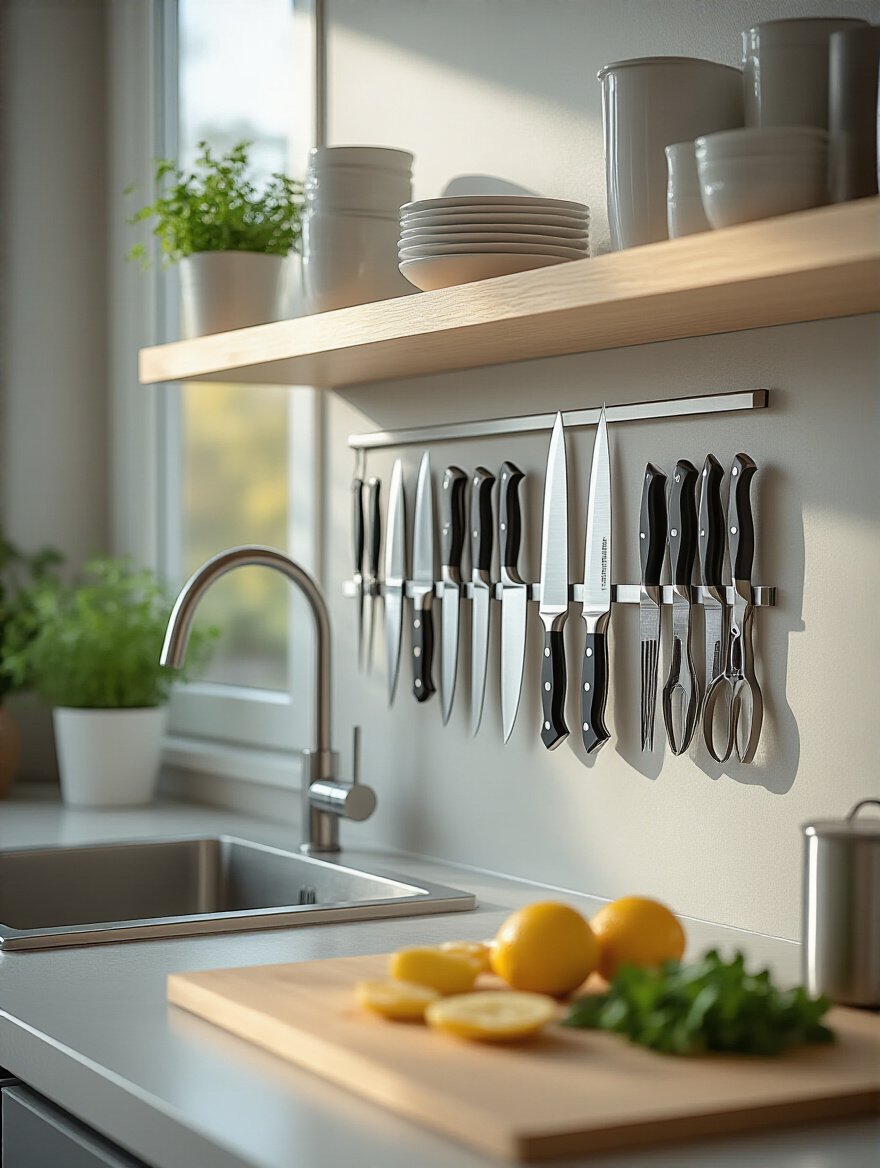
Think of the visual rhythm it creates—the gleaming steel of your knives against a colorful tiled backsplash or a warm brick wall. It’s a clean, graphic element that says, “A serious cook works here.” Just be sure to install it securely into studs. This is one thing you don’t want to mess up.
9. Integrate a Customizable Pegboard System
Pegboards get a bad rap; people think of a dusty garage. But I want you to re-imagine it. Picture a large pegboard, painted in a deep, vibrant peacock blue or a warm saffron yellow. Now, imagine it kitted out with sleek wooden shelves, little wire baskets holding your garlic and onions, and hooks displaying your favorite utensils, a string of colorful measuring spoons, and maybe even a tiny hanging herb pot.
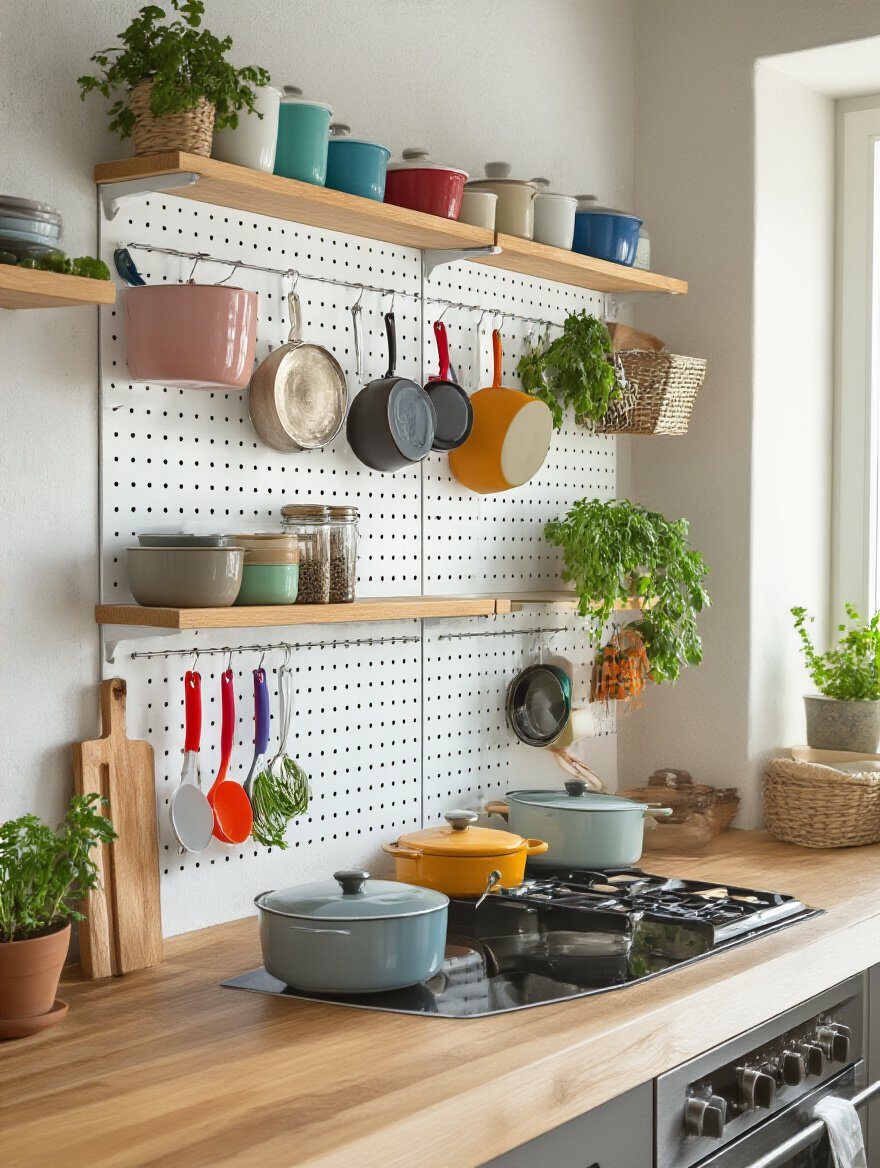
It’s the ultimate in flexible design. You can change it around whenever the mood strikes. A pegboard wall is a living, breathing organizational system that becomes a piece of art in its own right. It’s a playground for your kitchen tools.
10. Design a Practical Chalkboard Wall for Daily Life
A chalkboard wall is so much more than a trend. It’s a communication hub. It’s where you can write the menu for the week, a grocery list, or a sweet note for your family. I love seeing clients write a favorite quote or even a word in another language—like “shukriya” (thank you)—to set the tone for the day.
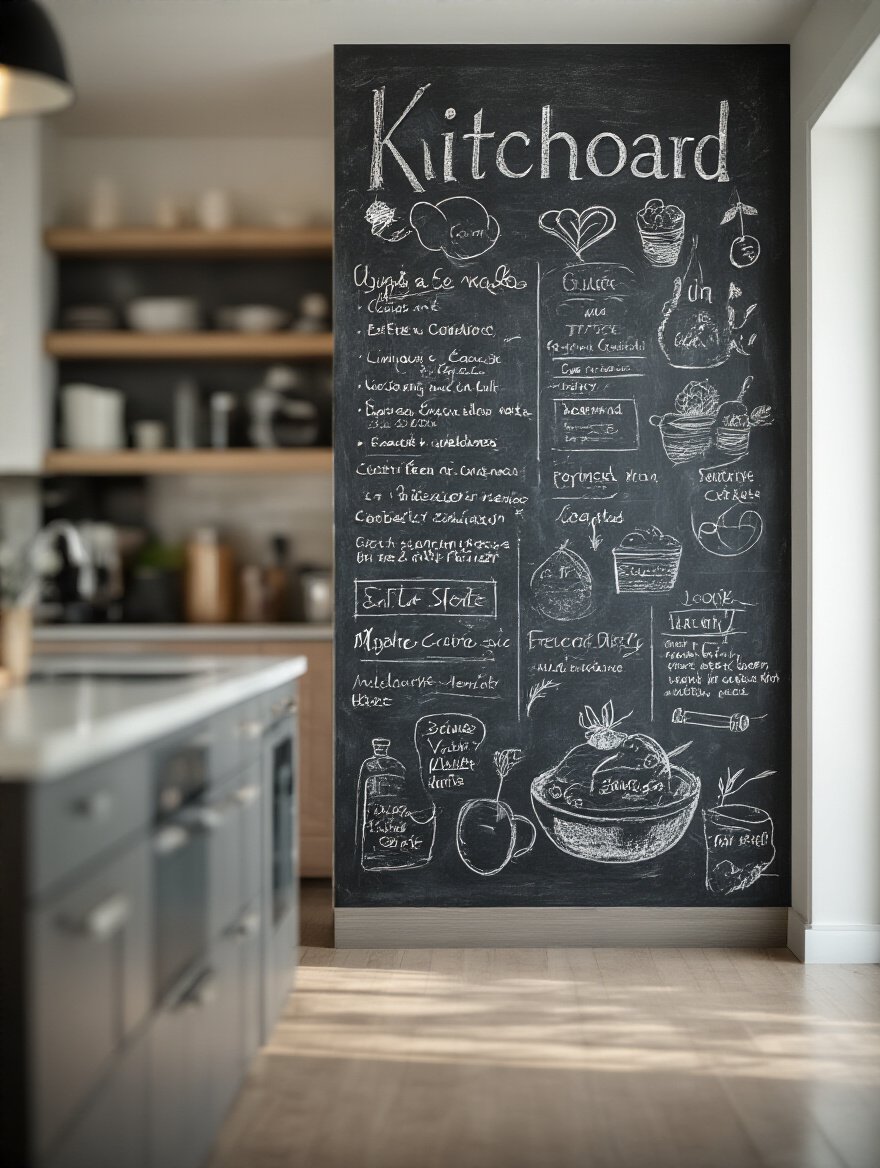
My advice? Don’t just paint a random square. Be intentional. Frame out the chalkboard section with some beautiful trim molding to give it a finished, picture-frame look. And use liquid chalk markers! They’re so much cleaner and more vibrant than dusty old chalk. It’s a functional piece that brings a sense of interactive, ever-changing charm to the room.
11. Add a Wall-Mounted Spice Rack for Your Flavor Library
In any Indian kitchen, the masala dabba (spice box) is the heart of the operation. A wall-mounted spice rack is just a beautiful, expanded version of that. It turns your spice collection into a vibrant, visual library of flavor. Why hide all those beautiful colors—the fiery red of chili, the earthy gold of turmeric, the deep brown of clove—in a dark cabinet?
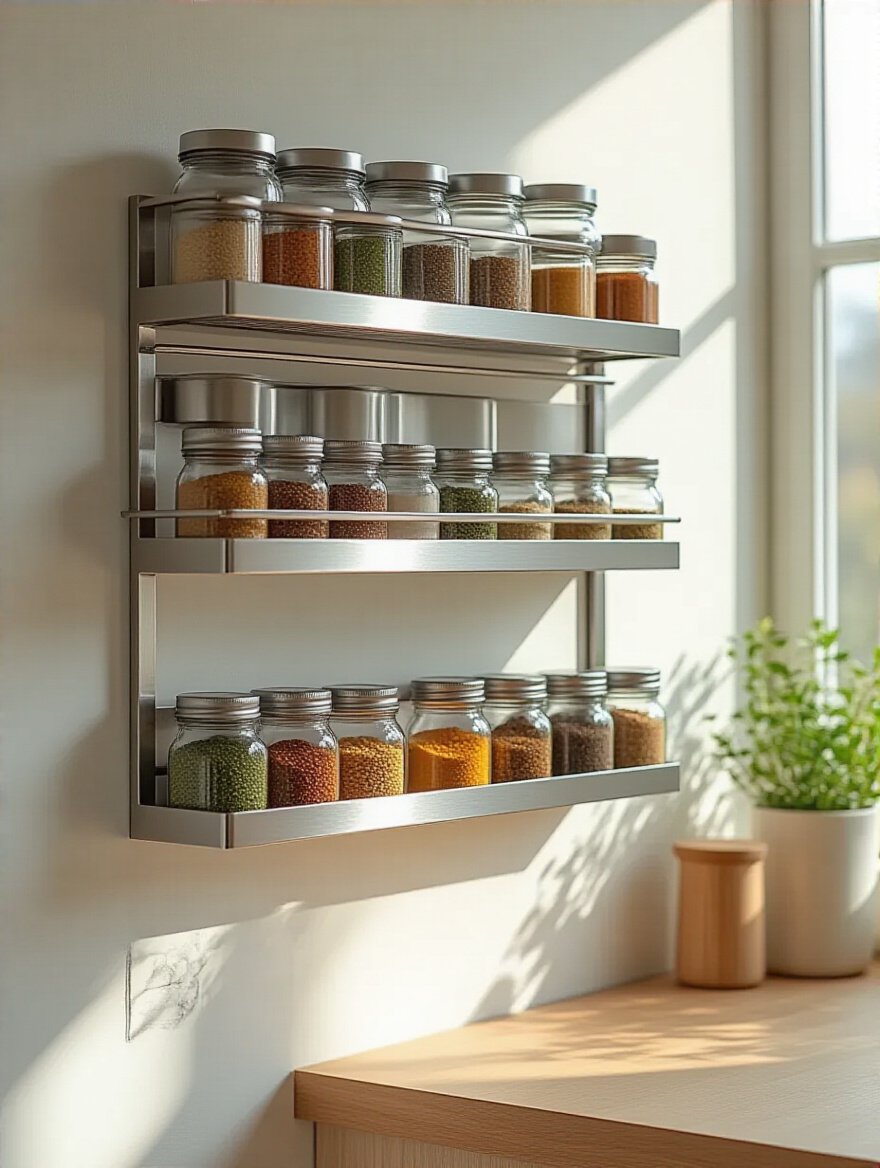
Find some beautiful uniform glass jars and display them with pride. You can organize them by color for a stunning rainbow effect or by cuisine. Not only does it look incredible, but it makes cooking so much more intuitive when you can see your entire palette of spices at a glance. It’s the ultimate fusion of function and fragrant beauty.
Telling Your Story in Color & Texture
This is where the soul of the kitchen really comes through. We’re moving beyond function and into pure, joyful expression. This is your chance to hang things on your walls that have history, meaning, and a story to tell. Don’t be afraid of color or pattern here. Be bold.
12. Curate a Themed Gallery Wall with Meaning
A gallery wall shouldn’t look like you just bought a pre-packaged set from a big-box store. It should look like a collection of memories and loves. The theme is you. Frame a vintage Indian movie poster next to a black-and-white photo of your grandparents. Add a botanical print of a cardamom plant, a small, intricate piece of embroidery, and a modern abstract print that picks up the colors from everything else.

The secret is to have a unifying thread. Maybe it’s a color that runs through every piece, or maybe all the frames are the same simple black or warm wood. I once helped a client create a gallery wall that was just her children’s art, but we put each piece in a gorgeous, grown-up frame. It was deeply personal and looked incredibly chic.
13. Apply a Statement Accent Wallpaper or Removable Decals
Can we talk about how wallpaper can completely change a room’s energy? A bold, patterned accent wall is one of the fastest ways to inject serious personality into a kitchen. I adore using patterns inspired by Indian design—a beautiful Mughal-inspired floral, a geometric jaali screen pattern, or a vibrant paisley. It can act as a backsplash behind shelves or fill a whole wall in a breakfast nook.
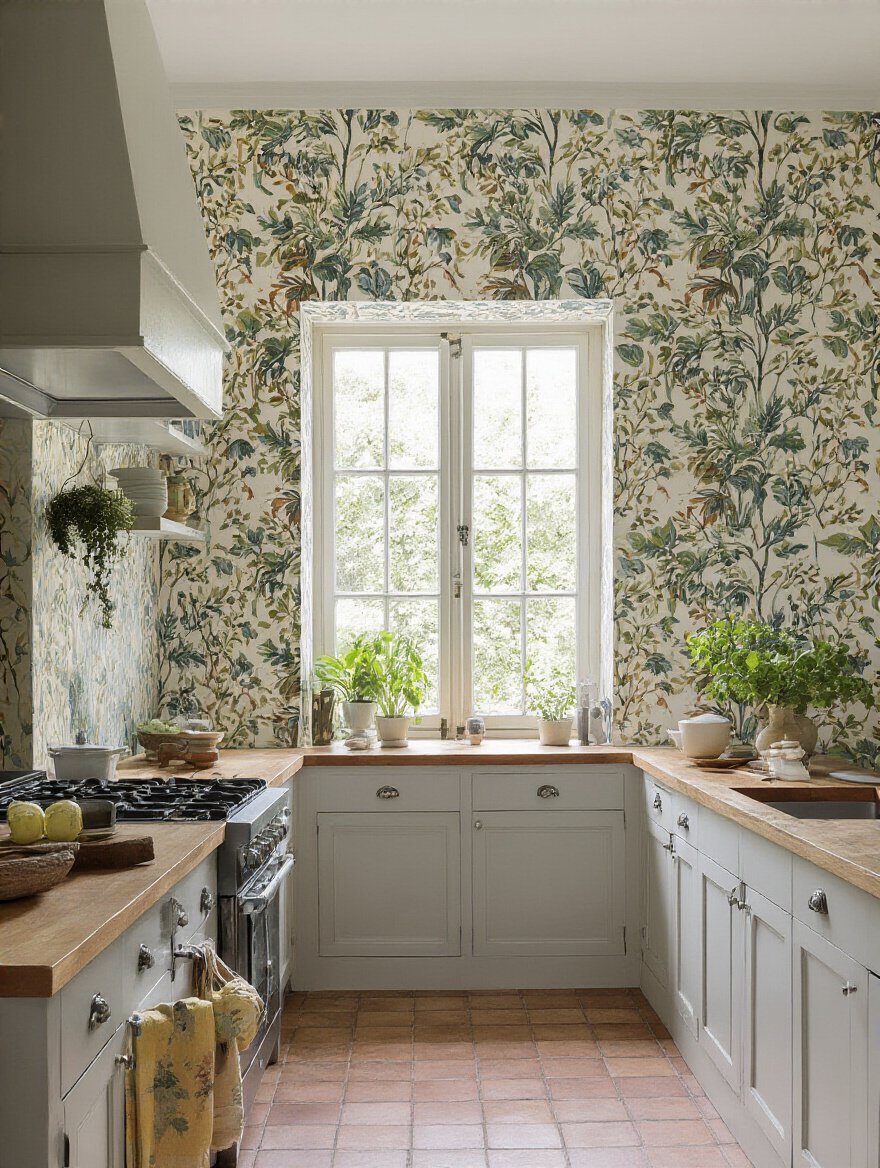
And for those who are a little nervous about commitment (or are renting!), removable decals are a gift from the design gods. You can get the same high-impact look with zero long-term stress. It’s a low-risk, high-reward way to play with pattern and color. A client used a beautiful Sanganeri block-print-inspired decal behind her white open shelves, and it instantly made her whole kitchen look custom-designed.
14. Incorporate Strategic Mirrors to Expand and Enchant
In India, you’ll see palaces like the Sheesh Mahal, where the walls and ceilings are covered in tiny, intricate mirrors that shimmer and dance in the light. You can bring a touch of that magic into your own kitchen. A mirror is not just a mirror; it’s a tool for manipulating light and space. A large, well-placed mirror can make a small kitchen feel twice as big and infinitely brighter.
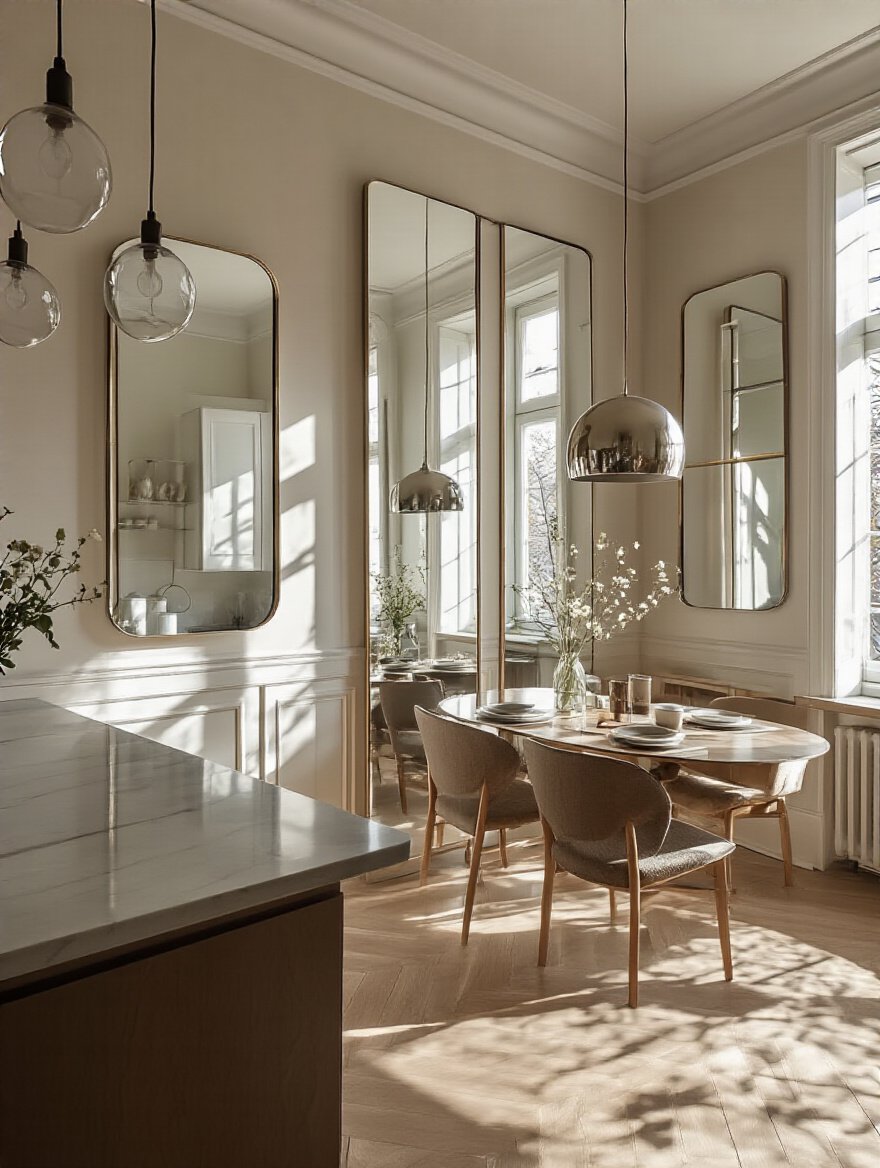
Forget the boring, frameless bathroom mirrors. Find one with a story. Look for a mirror framed with antique carved wood, one with a bone or mother-of-pearl inlay, or even a cluster of smaller, mismatched mirrors. Hang it opposite a window to double your natural light. It adds depth, sparkle, and a touch of glamour.
15. Display Unique Decorative Plates or Platters
Hanging plates on a wall is a tradition that spans cultures for a reason: it’s beautiful! It’s an instant collection and a fantastic way to bring in color and pattern without the expense of a large painting. Instead of traditional floral plates, why not showcase a collection of vibrant, hand-painted Blue Pottery from Jaipur? Or maybe some rustic, hand-thrown terracotta platters.
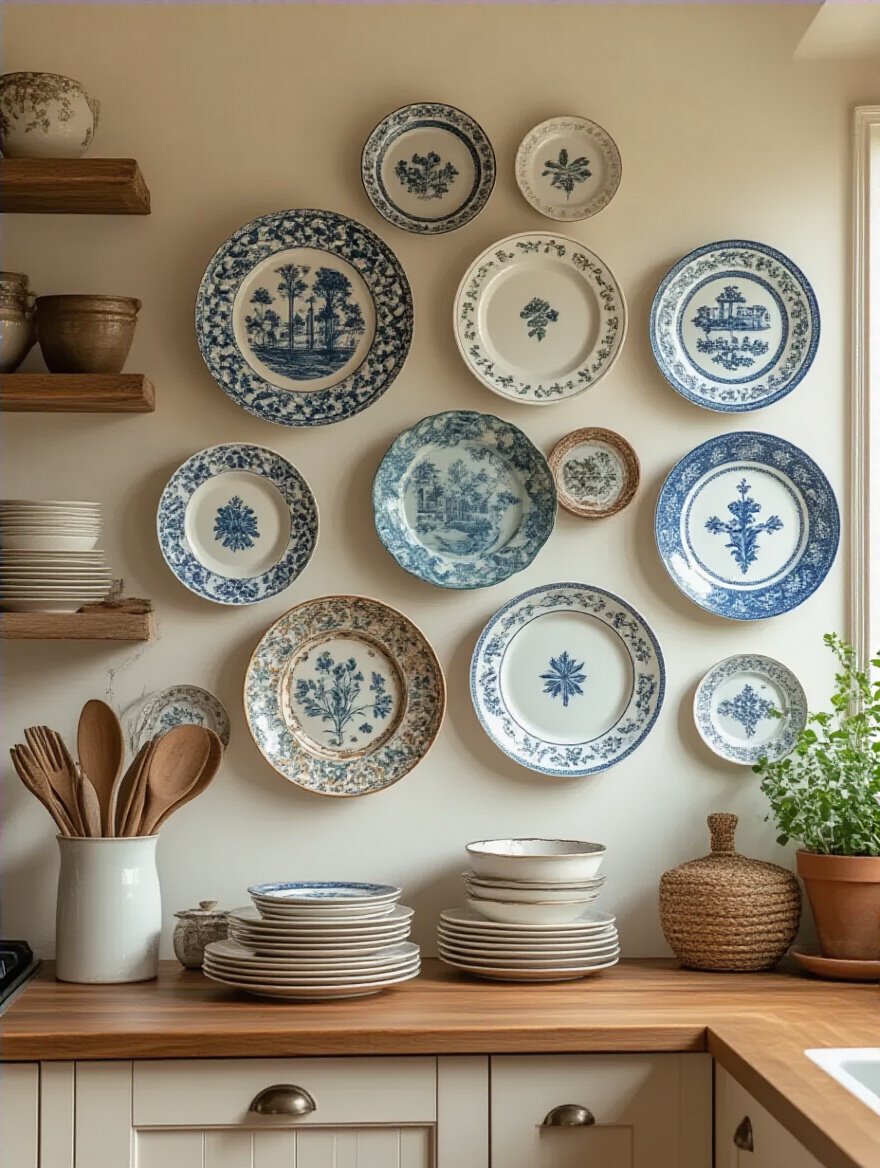
I love to mix and match sizes and even shapes to create a dynamic, flowing arrangement. A collection of plates climbing up a narrow wall can draw the eye upward and make the ceiling feel higher. It’s a simple, classic idea that you can personalize to reflect your travels, your heritage, or simply the colors you love.
16. Hang a Large, Visually Striking Clock
A large clock is so much more than a way to tell time. It’s an anchor. It’s a bold, graphic piece of art that can ground an entire wall. Forget the standard, functional clocks. Find one with real presence. Think oversized, with wrought iron details, or maybe a massive one made from a slice of reclaimed wood.
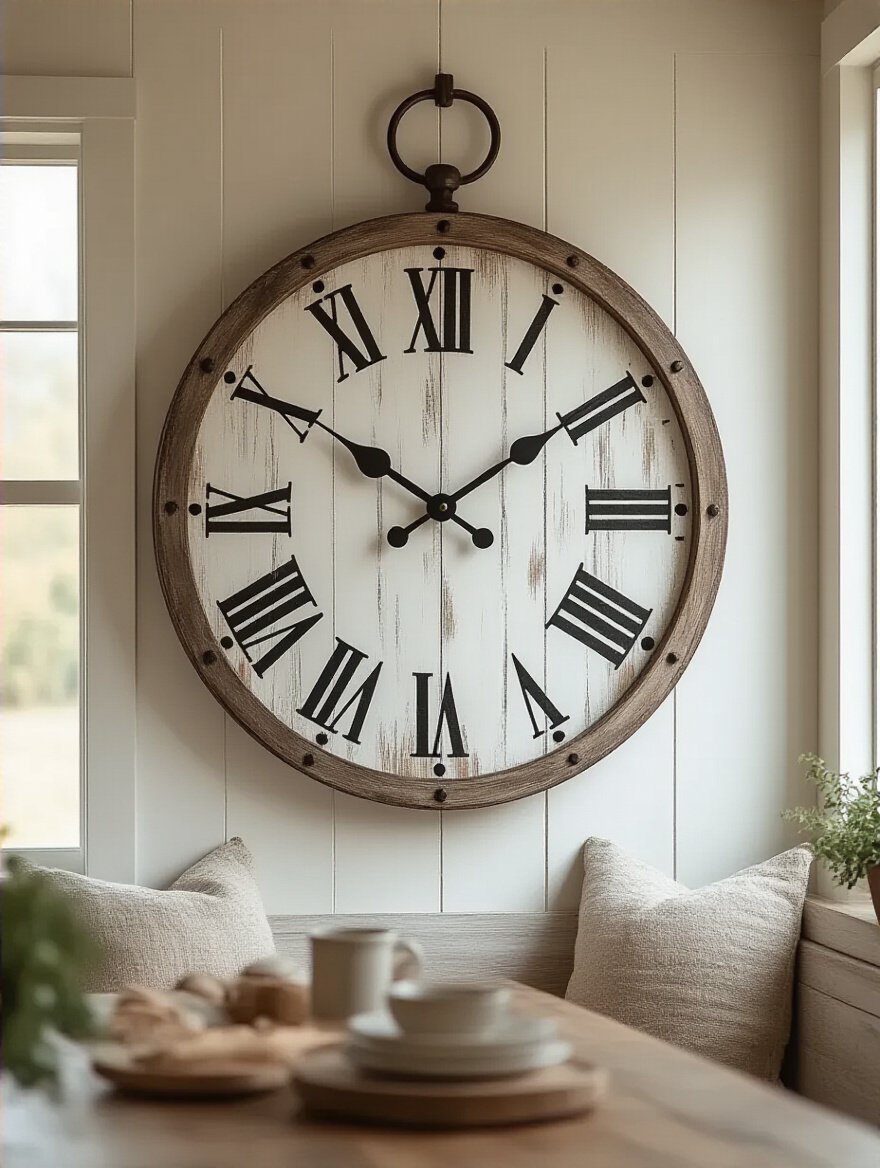
I once found a stunning clock for a client that used Devanagari numerals instead of Roman or Arabic ones. It was a subtle, beautiful nod to her heritage and a major conversation piece. Find a clock that reflects your style, give it a prominent place on a big, empty wall, and let it command the space.
17. Introduce Vibrant Textile Wall Hangings for Softness and Warmth
Ah, this is my absolute passion. Kitchens are full of hard, cold surfaces—stone, steel, tile. A textile is the perfect antidote. It brings in softness, absorbs sound, and drenches a wall in color and texture. We’re not talking about a flimsy macrame hanger. I’m talking about a true piece of art. Hang a vintage Kantha quilt from Bengal, with its millions of tiny, colorful hand-stitches. Or a block-printed kalamkari panel from Andhra Pradesh, telling an ancient story.

I once met a woman in a small village in West Bengal who made Kantha textiles. She told me, “Every stitch is a prayer.” When you hang something like that in your home, you’re not just decorating. You are hanging a story, a prayer, a piece of someone’s life on your wall. It’s a shortcut to a room with soul. Just be sure to hang it away from the stove and sink to protect it.
The Heartbeat of Your Home: Personalized Touches
These final ideas are deeply personal. They are about weaving your own history, your passions, and your love into the very walls of your kitchen. This is what transforms a house into a home.
18. Frame Beloved Family Recipes for a Sentimental Story
This might be my favorite idea of all. Find a recipe card, handwritten by your mother or grandmother—the one for her famous biryani or perfect apple pie. The one with the little splatters and faded ink. Scan it at high quality and have it professionally printed on archival paper, then frame it beautifully. It is the most powerful art you will ever own.
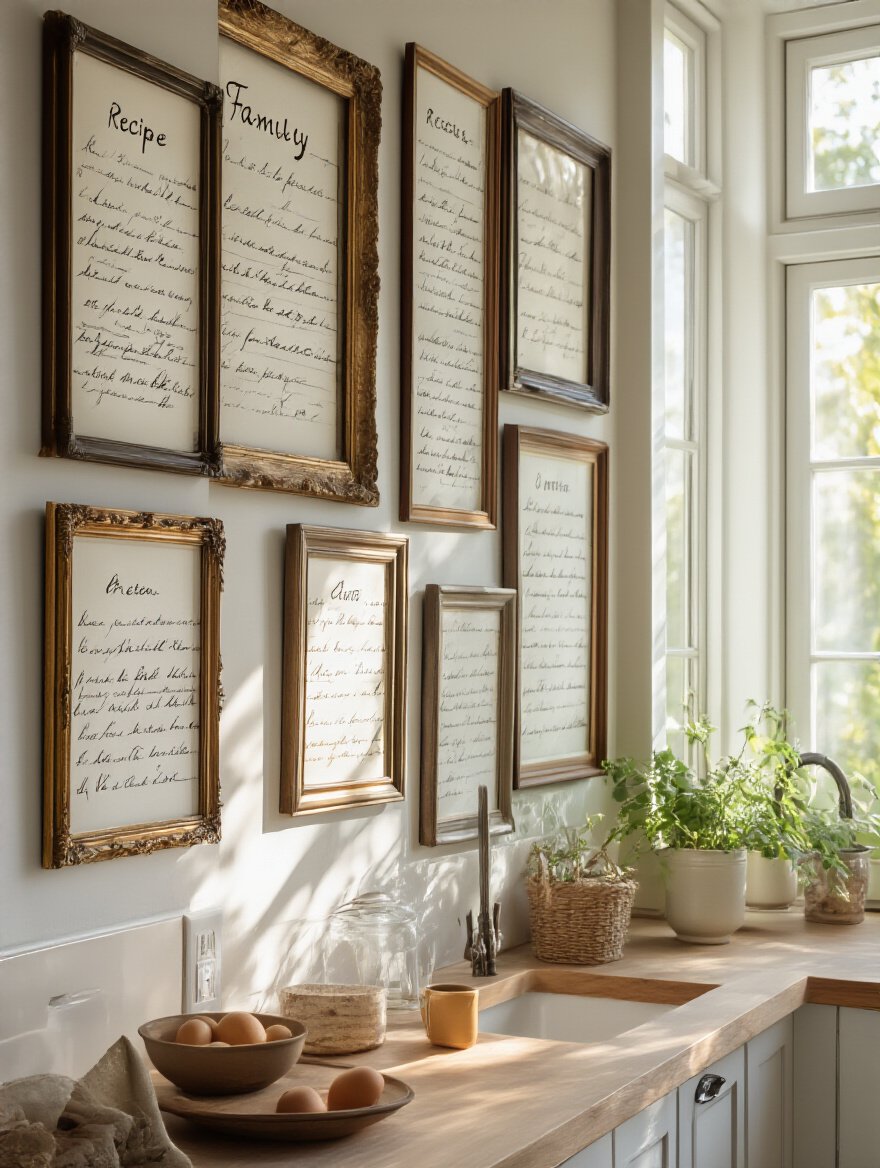
A grouping of these—your aunt’s cookie recipe, your father’s barbecue sauce instructions—becomes a gallery of love. Every time you look at it, you’ll feel that connection. I helped a client frame his grandmother’s handwritten recipe for pickles, and he said it felt like she was right there in the kitchen with him. That’s a feeling you can’t buy in a store.
19. Utilize Architectural Salvage for History and Charm
Give me an old door over a new piece of art any day. Architectural salvage pieces have a history, a soul, a story etched into their very grain. Hunt for treasures at flea markets and salvage yards. An old, arched window frame from a dismantled villa can become a stunning focal point above your sink. A beautifully carved wooden panel from an old haveli (a traditional Indian mansion) can be mounted as pure art.
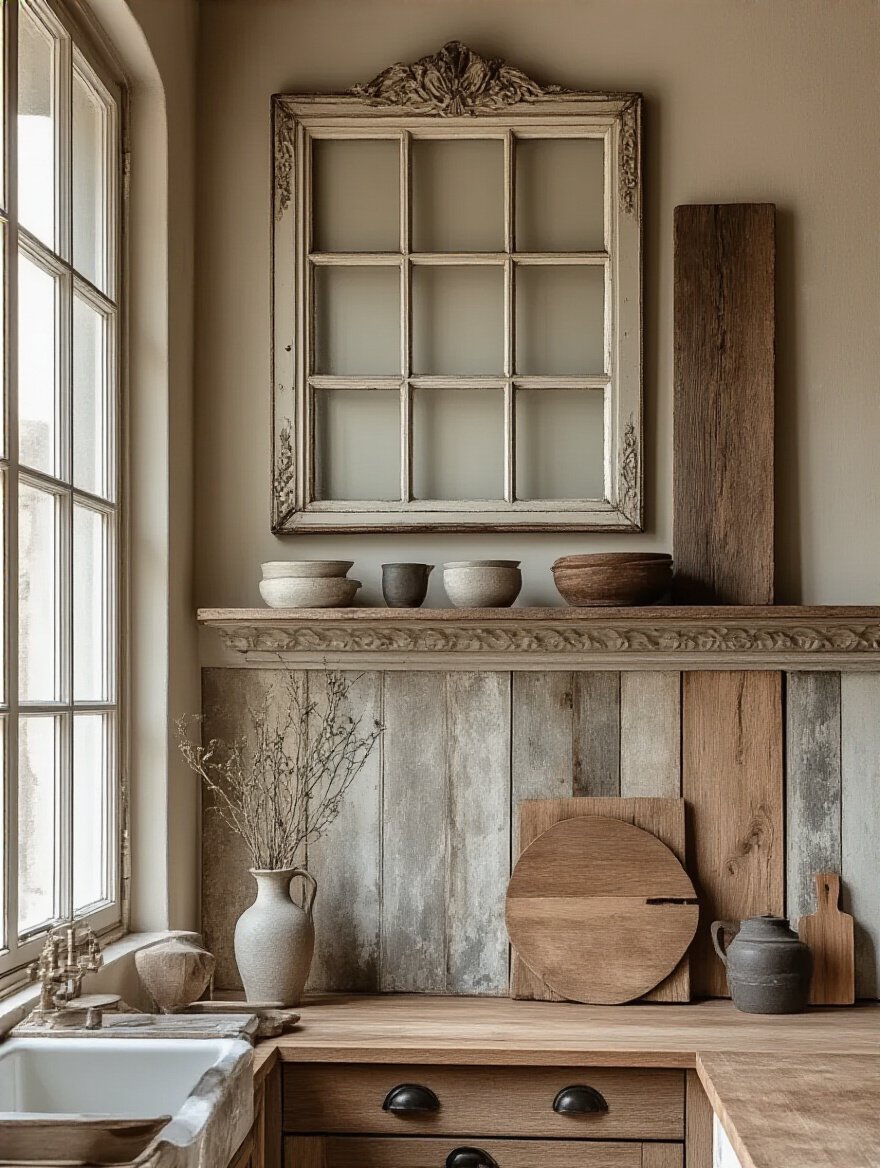
These pieces bring a sense of timelessness and authenticity that is impossible to fake. I love pairing a rustic, weathered piece of architectural salvage with sleek, modern kitchen elements. The contrast is electrifying. It tells a story of where you’ve been and where you are now.
20. Showcase Indoor Herbs in Stylish Vertical Wall Planters
What could be more beautiful and practical than a living wall of fresh herbs? A vertical garden in your kitchen brings life, color, and fragrance right where you need it. It’s a piece of decor that you can actually eat! Imagine reaching over to snip some fresh mint for your chai or cilantro for your curry.
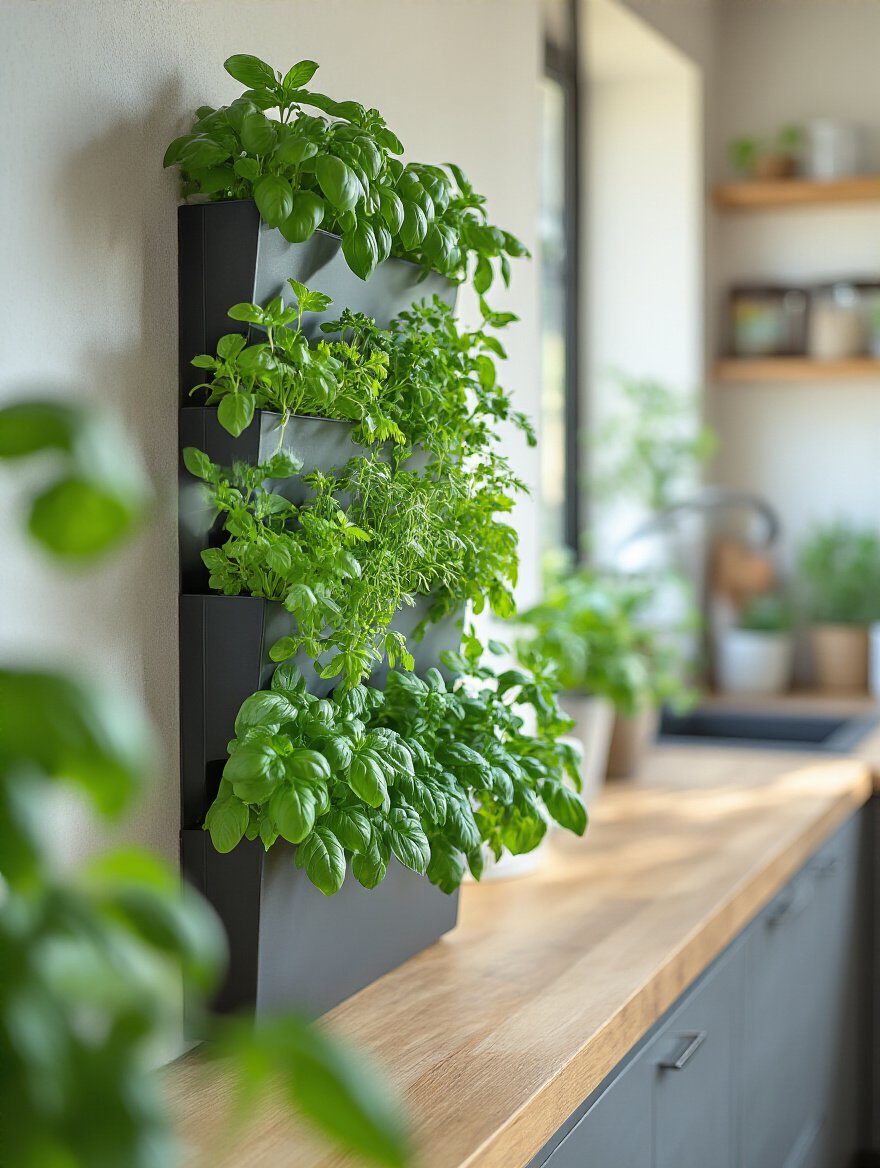
There are so many stylish systems now, from simple fabric pockets to sleek, self-watering modular units. It turns a blank wall into a lush, green focal point. It’s biophilic design at its most delicious, connecting you to nature while you cook and improving the very air you breathe.
21. Design a Custom DIY Stenciled Pattern
If wallpaper feels too daunting, a stencil is your secret weapon. You can create a custom, high-end look for the cost of a can of paint and a little patience. Find a stencil of a traditional pattern you love—a Moroccan tile, a lotus flower, or a classic paisley (ambi) motif. It can create the illusion of a tiled backsplash or a beautifully patterned accent wall.
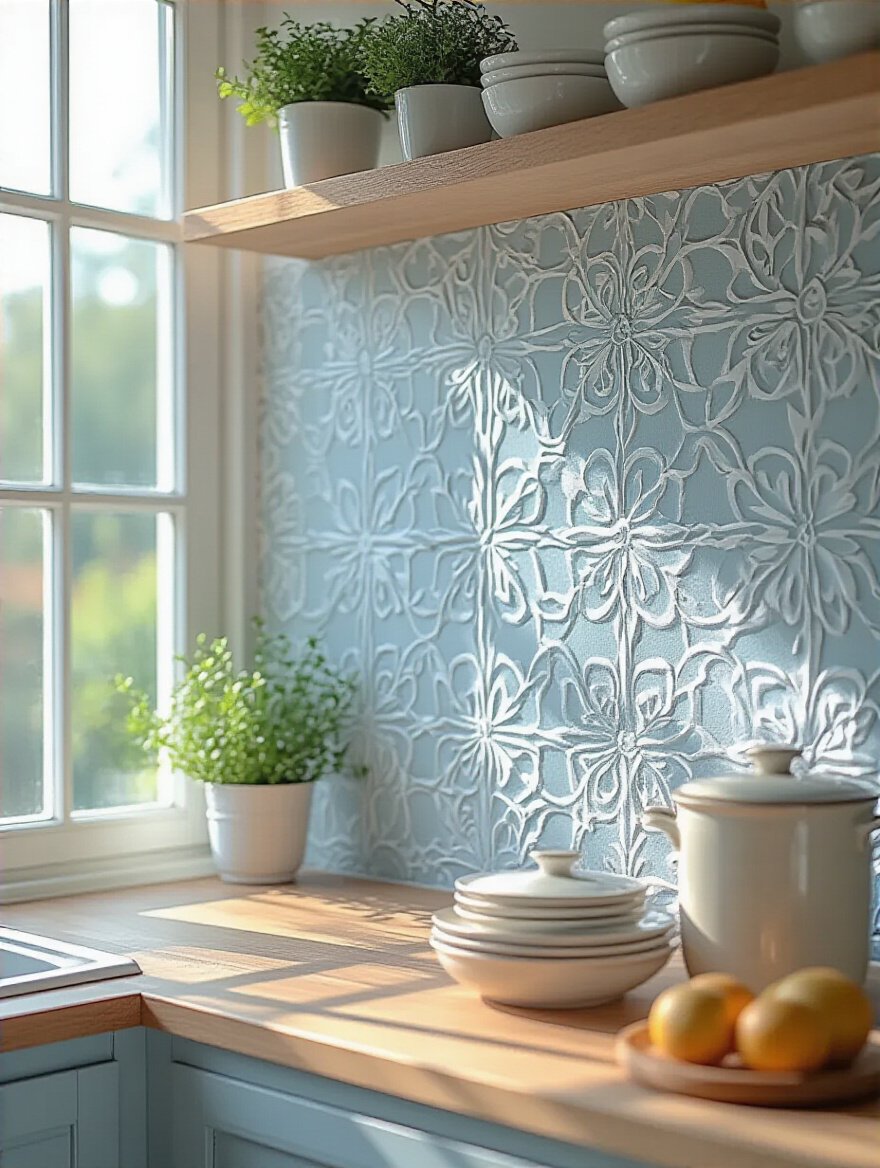
The trick is to use an almost-dry brush or roller to avoid smudging, and to plan your pattern out with a level before you start. It’s a weekend project that delivers a massive dose of personality. I love using a tone-on-tone approach—a glossy version of your wall color over the matte base—for a subtle, sophisticated texture.
22. Add Subtle Task Lighting with Wall-Mounted Sconces
Lighting is everything. And I don’t just mean the big light in the middle of the ceiling. Sconces are the jewelry of your walls. They add a warm, intimate layer of light that makes a kitchen feel less like a laboratory and more like a cozy bistro. Use them to flank a piece of art, light up your open shelves, or provide focused task light over a prep area.
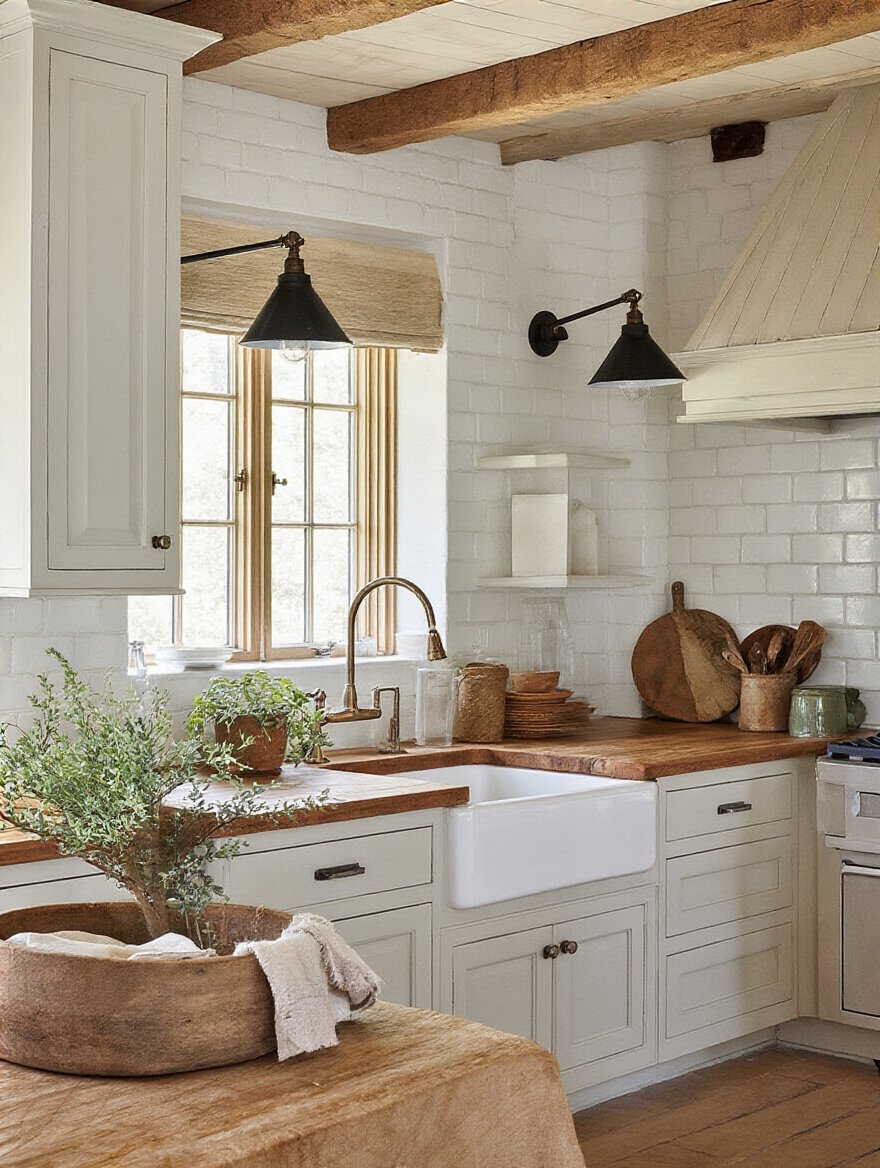
And be adventurous with the style! Instead of a generic modern sconce, what about a pair of pierced metal lanterns that cast beautiful, dappled shadows on the wall? Or a sleek, adjustable brass arm sconce that feels both industrial and elegant? The right sconces are the finishing touch that pulls everything together and makes your kitchen glow.
Your Culinary Sanctuary Awaits
Look, at the end of the day, your kitchen walls are a canvas. Don’t let them be an afterthought. They are an opportunity to surround yourself with things that inspire you, that connect you to your history, and that make the daily act of cooking a more joyful experience. It’s not about following a rigid set of rules; it’s about listening to your heart.
So forget the “shoulds” and start thinking about what stories you want to tell. Pick one or two ideas from this list that make your heart beat a little faster and just begin. Whether it’s framing a precious recipe or hanging a vibrant textile from a far-off land, you are weaving your life into the heart of your home. Dare to be bold. Dare to be personal. Your kitchen will thank you for it.
